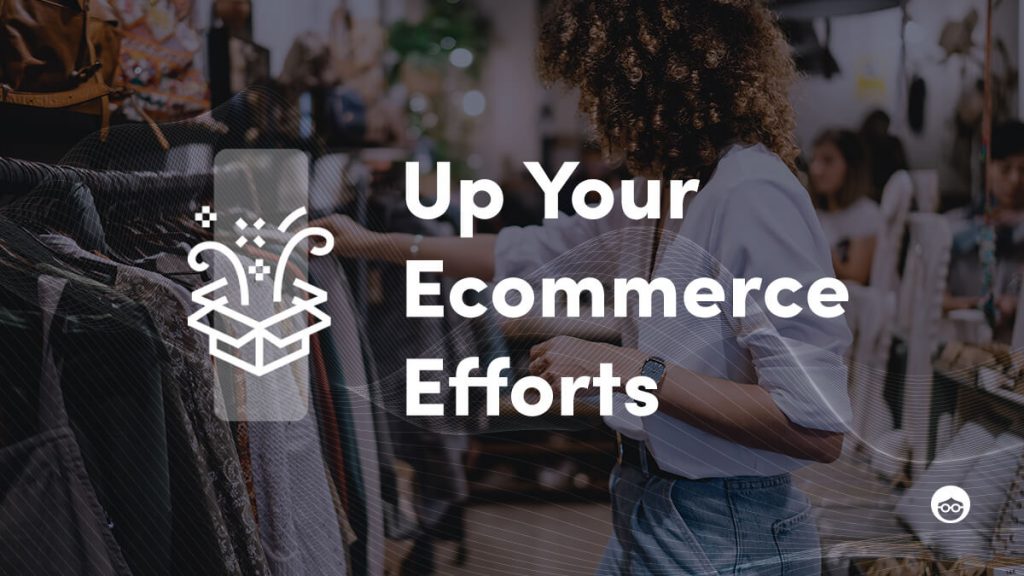Ecommerce Trends We’re Watching in 2021

Each new year comes with a fresh batch of technology trends, and 2021 is no different. But after 2020 rocked us all in one way or another, we’re keeping a watchful eye on a specific handful of ecommerce trends.
While we’re equipped with everything we learned in the past 12 months (such as how to pivot on a dime), there’s a chance that some of last year’s trends will morph into new ones. For example, according to insights from McKinsey & Company, digitization will continue to expand as a result of working from home, telehealth appointments, and online customer service efforts.
Additionally, last year forced us from our comfort zones, but that’s how things grew. Statista reported that 5% of customers aged 65+ made an online purchase for the first time because of pandemic-related restrictions. So, let’s review some of the key ecommerce trends in 2020 and explore where we’re going in 2021.
Looking Back at 2020, What Were Driving Trends?
The last year has seen many changes in the way consumers look for and purchase products online. The pandemic forced many in-store customers to go online, and those that were already shopping online shifted their purchasing habits. As a result, helpful options such as Buy Now Pay Later (BNPL) and real-time customer service grew in popularity.
1. Many businesses and customers used BNPL
BNPL is a way customers can purchase items today but pay under an installment plan agreement over a specified period. Statista reported that 2020 saw an increase in BNPL installment plans, with as many as 1.4 million initiated in September of last year.
The growth of BNPL coincided with the pandemic – from April to September 2020 – when consumers were likely experiencing financial instability. While BNPL has the appeal of a credit card, it doesn’t affect a consumer’s credit score in the same way.
2. Chatbots helped with real-time customer service
In 2020, IBM reported that as many as 40% of businesses in the U.S., China and Europe are using chatbots or virtual agents. Chatbots offer customer service immediately, instead of the customer having to wait a certain number of business days.
They can lead a customer to an FAQ page or inform them when they can expect a representative response. They can also provide additional product information or a coupon code.
2021 Ecommerce Trends the Industry Will be Testing
In 2021, we’re expecting growth in a few online areas, including omnichannel marketing and marketplaces. B2B brands that weren’t able to jump online last year are likely making an effort this year, and customer experience will be vital to retention. We also expect to see more brands contribute to environmental efforts in some way and make their websites more accessible for everyone.
1. Omnichannel marketing will grow
Having an omnichannel strategy means customers can engage with a brand across multiple platforms in different ways, and it all happens seamlessly. Omnichannel includes text messaging, email, social media, phone, chat, etc.
Implementing an omnichannel strategy is a way to engage with the customer in a way that satisfies them. This type of plan meets the customer while also making it a more effortless shopping experience. For example, maybe you receive a text message or see an ad for a store while you’re physically in their store.
Invesp reported that companies using an omnichannel marketing strategy had a customer retention rate as high as 89%. That rate is more than double the average rate of 33% brands typically see without using omnichannel.
Tips for trying it out:
To be successful with omnichannel marketing, make sure you know your customer’s journey inside and out. To meet the customer where they are, you have to know what steps a customer takes when they take them and in what order.
Where does your customer spend the most time? Make sure you select and focus on the proper channels for your strategy. If your customer uses email and social media the most, choose those channels over SMS text messaging.
Once you start implementing your omnichannel strategy, gather as much data as possible. Look at the data to see how the plan is working and where you can make improvements.
Also, don’t forget to optimize for various devices to make the user experience as smooth as possible. For example, a recently published research on customer experience expectations shows that more than 62% of Gen Z consumers primarily use phones when shopping online.
Source: Tidio
2. Online marketplaces will expand
A marketplace is a site that has several individual sellers or businesses managing their product listings, sales and shipping. Examples of a marketplace would be Amazon, eBay, Poshmark, Etsy or Facebook Marketplace.
Ebay launched in 1995 and is one of the original online marketplaces. Although eBay has seen a fair share of growth over the years, it reached a new high in 2020 when it surpassed $10.2 billion in net revenue. Its 2020 revenue was an increase from its $8.6 billion in revenue from 2019.
These marketplaces allow sellers to focus on making sales and leave logistics up to the platform they’re using. Millennials use marketplaces for personal purchases, so it’s no surprise that they’re using them for business, too.
Tips for trying it out:
It’s a good idea to sell your products on a marketplace in addition to your ecommerce site. If you’re already attracting customers to your website because of a specific product, you can reach an entirely new audience using the marketplace.
Carefully consider the products you put on the marketplace. If you make decent sales from your website, put the less-popular products on the marketplace to give them the spotlight. No matter what products you choose, put plenty of informative content on your product pages.
Make an effort to get reviews on the marketplace by sending reminders to customers. Most established marketplaces won’t allow sponsored reviews, but providing stellar customer service should do the trick. Customers rely on these reviews when deciding to make a purchase, so having a collection of them is helpful.
3. More B2B brands will adopt ecommerce
A survey from Demand Gen Report shows that not only are millennials working in upper-level positions within B2B companies, but they’re comfortable in ecommerce environments.
Statista expects B2B ecommerce sales to reach $1.2 trillion this year, thanks to millennials. While the pandemic forced many businesses to shift to an ecommerce model, even more B2B customers want online transactions. If the customers are online, the brand will follow.
Moving online has many advantages for B2B entities, including an array of payment options. Traditional B2B commerce still involves paper checks and purchase orders, while ecommerce allows for digital payments. A study from Juniper Research expects half the global population will use a digital wallet by 2024.
Switching from traditional B2B to ecommerce means companies will utilize robust platforms. Ecommerce platforms often make for a better customer experience on the front-end paired with sophisticated data collection on the back-end.
Tips for trying it out:
Start by choosing an ecommerce platform that meets your business’s current needs and leaves room for future growth.
Ensure the platform will provide a great customer experience and meet your back-end needs regarding security, data collection and product capacity. It would be best to consider how a platform integrates with third-party vendors and apps to make your business run efficiently.
Some ecommerce platforms come backed with a team that will migrate your website to make the transition seamless. Having help with the website also means you can focus on other business areas during the migration.
4. Customer experience will be a key driver for success
With smartphones at their fingertips, customers have 24/7 access to the internet. Constant access gives customers the ability to do loads of research on brands, products and services as they decide how and where to spend money.
Brands that provide customers with the experience they’re looking for – at all touchpoints – will earn customer loyalty. According to Statista, companies worldwide will spend more than $640 billion on customer experience technology by 2022.
Different technology can help create a great customer experience:
- Augmented reality (AR): More people are shopping online for things they would typically go to a brick-and-mortar store for, and this technology can bring something to life (such as a fitting room). AR also positions your brand as forward-thinking, which is attractive to younger audiences.
- Headless commerce: Headless commerce is a solution that separates an online store’s front-end from its back-end. With headless, brands have greater control and flexibility with their content and customer journey. Headless commerce is growing in popularity because it provides a better, more personalized customer experience.
- Product videos: A product video shares information about the product features and how it works. Product videos can have different formats, including product demos, how-to, unboxing, close-ups or reviews. Customers often prefer watching a video instead of reading chunks of text.
- Personalization: Companies have access to tons of customer data, including how many times they’ve interacted with the brand, the items they look at, and what makes them ultimately convert. The twist is, customers know you’re collecting this data, and they expect you to use it to their advantage.
5. Sustainability will be looked at more closely
As more consumers become aware of our daily impact on the environment, they’re also paying attention to how brands consider sustainability.
Statista reported that 42% of brands considered sustainability options – such as eco-friendly packaging – in 2019. A survey revealed that millennial and Gen Z consumers are willing to pay as much as 20% more for products that benefit the environment.
Here’s how brands can be more sustainable:
- Having less packaging or recycled packaging
- Sell products that help customers be more eco-friendly
- Contribute to an environmental cause
- Implement a recycling program that rewards customers
Tips for trying it out:
Choose a way to help the environment while sticking to your original company mission. Switching to paperless options or using recycled packaging is always a brilliant place to start.
Once you try something new, ask for customer feedback and be open to change. The more transparent you are about your sustainable efforts, the more customers will appreciate them.
6. Accessibility will be on everyone’s roadmap
Accessibility involves taking steps to ensure that your website and its content is available to everyone, including users who may be impaired or have special needs.
According to the World Health Organization, more than 1 billion people live with a disability. The ultimate goal is to eliminate any and all barriers on a website so that anyone can access and easily understand its contents.
Without accessibility, you’re losing out on serving customers who may be blind, hearing impaired, or have additional needs.
Tips for trying it out:
The standard for accessibility comes from the Web Content Accessibility Guidelines (WCAG), which includes accepted text, images, sound and code.
In addition to WCAG, there are website checkers that scan your site and produce action items to increase the site’s accessibility.
Are All Trends Worth Trying?
There will always be trends popping up and ones that won’t stick around for long. How do you know which one is worth your time, effort and budget? The answer for this will be different for each business, but you can do a few things to evaluate industry trends.
1. Know your audience
The better you know your audience, the better you’ll be able to tell if a new way of business will align with them or not. If your customer base enjoys shopping via weekly email newsletters, doing more Instagram live videos may not affect your bottom line. Do things to keep engaging with – and getting to know – your customers, such as requesting their feedback or conducting a survey to see what’s important to them.
2. Do industry research
Keeping up with the latest news and research in your industry will help you evaluate upcoming trends. Industry leaders and influencers will likely have something to say about what’s new. If they tried it and can provide opinions you trust, that’s worth considering.
3. Look to see what your competitors are doing
It’s always a bright idea to keep an eye on your competition. If they’re jumping on a trend you’re considering, use them as a test model. Does it seem to be working for them? If you have similar audiences, this is an excellent way to determine what works (and what may not work) before investing.
Wrapping Up
As you can see, there are a lot of interesting trends coming our way. In 2020, we saw the rise of BNPL and the use of chatbots – both a clear result of the pandemic’s impact on ecommerce.
This year, we expect consumers to continue to shop online, and brands will meet them along the way via omnichannel marketing. More brands will also explore selling in marketplaces to reach a new segment of customers.
And while having a solid online presence is important, customer experience will be vital for success and retention. Part of that experience includes efforts in sustainability and accessibility.
All of these trends have pros and cons, but they’ll be different for each business and industry. Evaluate this year’s trends to see if they make sense for your customer and your business before investing time, funds and resources.











